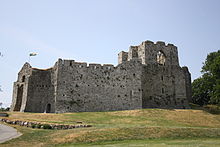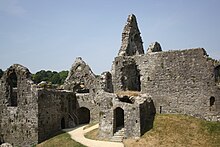Oystermouth Castle
| Oystermouth Castle | ||
|---|---|---|
|
Oystermouth Castles via Mumbles |
||
| Creation time : | 12th to 14th centuries | |
| Castle type : | Hilltop castle | |
| Conservation status: | ruin | |
| Geographical location | 51 ° 34 '35.2 " N , 4 ° 0' 10.7" W | |
|
|
||
Oystermouth Castle ( Welsh Castell Ystum Llwynarth ) is a ruined castle on the Gower Peninsula in south-west Wales. The ruin, classified as a Grade I cultural monument and protected as a Scheduled Monument , is located on a hill above the town of Mumbles and overlooks Swansea Bay. The ruins of Oystermouth Castle are considered to be the best preserved castle on the Gower Peninsula.
history
The history of the castle is closely tied to the history of Swansea Castle . In 1106 Henry de Beaumont became the first Norman lord of Gower. As a reward for his followers, he distributed the fertile farmland of his new possession among them and built Swansea Castle for himself.
The place Oystermouth was given to William de Londres , who built a first castle there, which probably consisted of a simple ring wall with a bailey . In 1116 the castle of Gruffydd ap Rhys was burned down but rebuilt. In 1184 the castle fell to William de Beaumont , who, however, had to cede the rule of Gower including the castle Oystermouth to the crown in the same year to pay off debts. In 1203 King Johann gave Ohneland Gower to William de Braose . In 1209/10, however, the Williams lands were confiscated by the king and handed over to the Earl of Pembroke for administration. In 1215 the castle was conquered and destroyed by Rhys Ieuanc and Rhys Gryg , allies of the Welsh prince Llywelyn ap Iorwerth . Llywelyn forgave Gower to his son-in-law Reginald de Braose , a son of William de Braose. However, after Reginald had reached an agreement with the king in 1217, Llywelyn Gower forgave Rhys Gryg, who again destroyed the castles on Gower. In 1220 Llywelyn finally handed the castle over to Reginald's nephew John , who had also married one of his daughters. John promptly rebuilt the castle as a stone castle, which became the primary residence for him and his successors in place of Swansea Castle. John's son William continued to expand the castle due to the wars with the Welsh principalities. In 1258 the castle was attacked in vain by Llywelyn ap Gruffydd . On December 10, 1284, King Edward I stayed at the castle during his inspection tour of Wales. During the uprising of Rhys ap Maredudd , the castle was conquered after a two-week siege in 1287, but the rebels could not hold the castle and retreated to Deheubarth. After the death of William de Braose in 1326, his daughter Alina inherited the castle. After her death around 1331, the castle was neglected because her son and heir John Mowbray and his heirs no longer resided on Gower and their caretakers lived again at Swansea Castle.
The castle eventually fell to the Somerset family, the later Dukes of Beaufort , but the castle had fallen into ruin by the 16th century. The castle was first restored in the 1840s and 1870s by the archaeologist George Grant Francis. The 10th Duke of Beaufort sold the ruin to Swansea Bourough Council in 1927. An extensive restoration and securing of the ruin began in autumn 2010. The £ 3.1 million restoration brought a lot of new knowledge to the building history and was completed in June 2012.
The ruin now belongs to the City and County of Swansea and is overseen by the Friends of Oystermouth Castle , a local development association founded in 1989. The ruin is used for numerous events and can be visited from the end of March to the end of September.
investment
Most of the structures preserved today date from the 13th and early 14th centuries. The oldest preserved part of the castle is the stone keep , which was probably built before 1141. The rectangular tower stands on the highest point of the castle complex and was originally free-standing, but was rebuilt several times in the 13th century and expanded with adjacent residential and farm buildings. On the first floor there was a large hall and behind it the private rooms of the lords of the castle. In the 13th century the mighty curtain wall , crowned by a battlement, was built, which encloses the castle in the east and west. In the south of the castle is the main gate, also built in the 13th century. The gate was originally flanked by two round towers, but these have not been preserved. The castle courtyard is dominated today by the three-storey chapel wing on the east side of the castle, which was probably built between 1327 and 1331 under Alina de Braose. During the restoration, which was carried out until 2012, a glass bridge was installed on the second floor of the building, so that the former chapel there with its lavishly designed tracery windows is again accessible to visitors today.
Others
According to legend, the White Woman of Oystermouth walks around the ramparts, terrified visitors with her inconsolable sobbing and is said to be the ghost of a woman murdered in dungeon.
On September 27, 2013, Princess Anne visited the castle.
Web links
- City and County of Swansea: Oystermouth Castle
- The Glamorgan-Gwent Archaeological Trust: Oystermouth Community Project
- Explore Gower: Oystermouth Castle
- Castles of Wales: Oystermouth Castle
Individual evidence
- ^ British Listed Buildings: Oystermouth Castle, Mumbles. Retrieved June 26, 2013 .
- ↑ Ancient Monuments: Oystermouth Castle. Retrieved December 19, 2013 .
- ^ Adrian Pettifer: Welsh castles. A guide by counties . Boydell & Brewer, Woodbridge 2000, ISBN 0-85115-778-5 , p. 103
- ↑ Royal Commission on the Ancient and Historical Monuments of Wales: An Inventory of the Ancient Monuments in Glamorgan : III - Part Ib: Medieval Secular Monuments the Later Castles from 1217 to the present, Her Maj. Stat. Office, 2000, ISBN 0-11-300035-9 , pp. 11f
- ↑ City and Council of Swansea: Oystermouth Castle conservation. Retrieved February 27, 2018 .
- ^ Diane M. Williams: Gower. A Guide to ancient and historic monuments on the Gower peninsula . Cadw, Cardiff 1998. ISBN 1-85760-073-8 , p. 5
- ↑ This is South Wales: Princess Anne visit to Oystermouth Castle. Retrieved December 15, 2013 .



